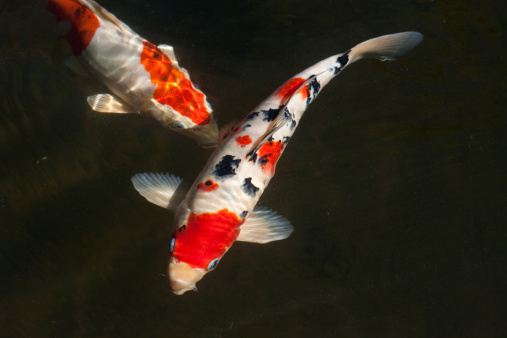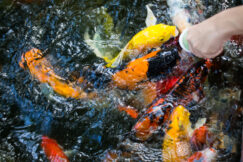The Sanke Koi fish has an interesting history, so let’s take a deeper look at what makes this one-of-a-kind creature so appealing and unforgettable.
What is Sanke Koi?
Originally named Taisho Sanke or Taisho Sanshoku, they are now popularly referred to as simply Sanke by most koi aficionados. However, they are, in reality, linked to Kohaku. Koi with black markings first appeared in Kohaku spawn in the early 1900s.
What does Sanke mean?
In Japanese, the phrase Sanke means ‘three colors.’ A Sanke is a three-colored koi that comes in white, red, and black. It is recognizable as a white koi with a red pattern and occasional black spots.
What is Gosanke koi?
Gosanke (goh-SAHN-keh) is a koi fish classification that contains three subcategories: Kohaku, Sanke, and Showa. This group is still the most popular among hobbyists, and it is normally one of the first sorts of koi fish to make its way into a pond or tank.
Sanke Koi Colors
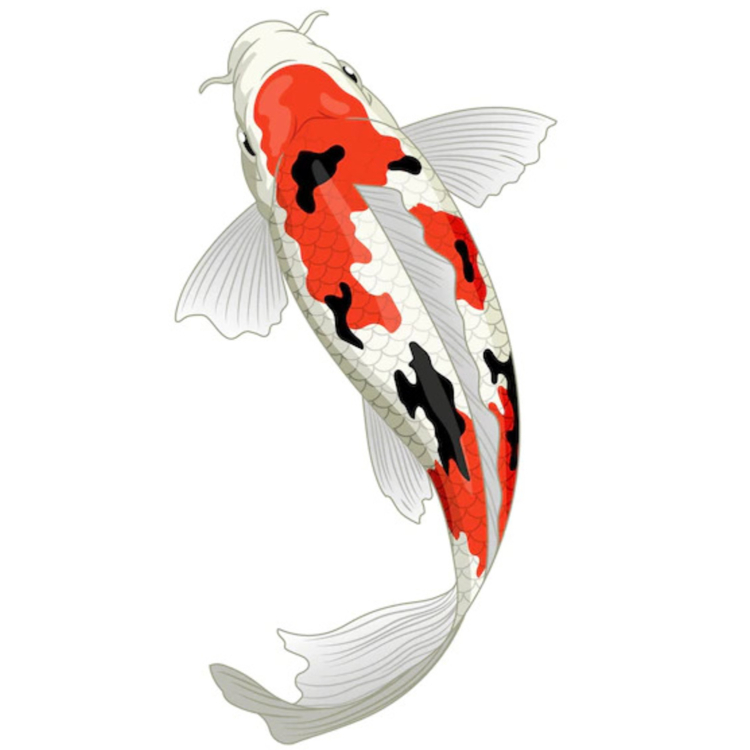
Sanke’s basic color is white, or shiroji (sheer-row-gee). It starts at the snout and works its way down to the tail, including the fins. It should be clean, bright, and free of discoloration.
Sanke origins
Eizburo Hoshino was motivated to cross one of these parent Kohaku with a Shiro Bekko (a white koi with black markings). The emerging fry showed tremendous potential, with the distinctive Sanke colors present roughly equal amounts, and a new variety was formed.
Since the first Sanke koi fish was exhibited at the Tokyo Exhibition in 1914, it has been a popular pet.
Since then, these beautiful koi have grabbed the hearts of breeders and casual owners alike, and Sanke koi fish have become familiar in exhibits and ponds worldwide. Sanke’s color and markings distinguish it unique from other koi fish.
How big does Sanke koi get?
Sanke koi fish may grow 2-3 feet tall and weigh 35-40 pounds. They are resilient cold-water fish that will thrive in temperatures ranging from 59 to 77 degrees F. (15-25 degrees C).
Characteristics of Sanke
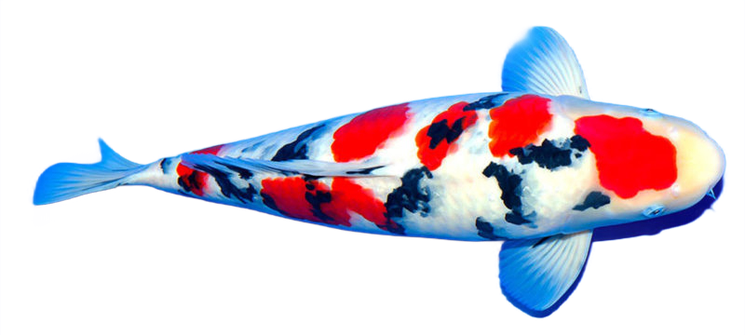
Sanke koi were the first tricolor (white, red, and black) koi to be created. It is the second of the ‘Big Three’ (Kohaku, Sanke, and Showa) koi, also known as Gosanke. They are white koi with huge hi (red) and smaller sumi (black markings) that are uniformly dispersed over the body.
The white, like Kohaku, should be snow-white and glossy, and the red marks (hi) should be rich in color with well-defined borders. The sumi should be deep black, but in young koi, it commonly appears pale blue or grey before fully developing.
To create an attractive pattern, the sumi should be dispersed uniformly throughout the body. While sumi may appear on either the hi (red) or white skin, Sanke with sumi on the white skin is greatly sought after.
In Japanese, the Red on Sanke is known as hi (he) or beni (ben-ny). Beni is more of an orange-toned red than a real fire engine red. Sanke are distinguished by big, reddish-orange patches that serve as the foundation of their color pattern, with the white base visible between the patches of beni.
Black, or sumi (sue-me), is a unique hue on Sanke. Sanke will typically feature black specks, or sumi markings, that are minor compared to the large beni patches. Sumi is an accent color, whereas Beni and Shiroji are the primary colors of Sanke.
Sanke’s head will often have only two colors: white and red, with no sumi. However, the face should be white since here is where the key beni pattern starts.
There are several parallels between Sanke and Showa. Aside from sharing three colors, both are non-metallic members of the Gosanke group, made with Doitsu and Ginrin scale variants.
To further complicate matters, they might seem extremely similar at a young age and can take several years to complete. So it’s no surprise that most people have trouble telling them apart, especially at first look.

What is the difference between Showa and Sanke koi?
The presence of sumi on the head is the most noticeable distinction between the Sanke and Showa. Sanke’s head will often have only two colors: white and red, with no sumi. On the other hand, Showa’s heads should have all three hues, including black. The face is where the bold Showa motifs begin.
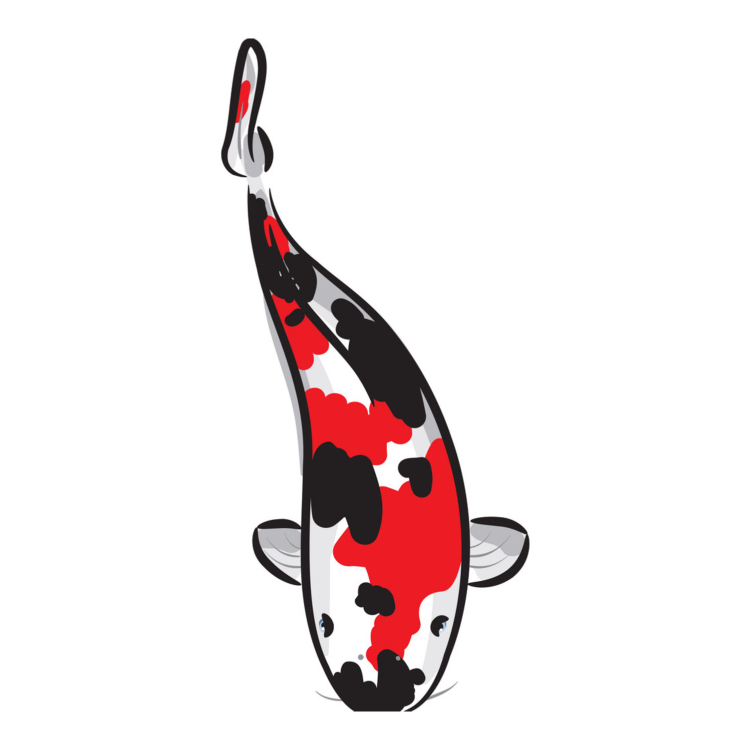
This is a key distinction between Sanke and Showa sumi, which are often significantly bigger and stretch down to the belly. Sanke pectoral fins frequently contain black stripes, but they should not have motoguro — a block of black at the base of the pectoral fin.

Here are some of the most prominent distinctions:
- The sanke is white with elements of red and black. The showa, on the other hand, is black with red and white highlights.
- The designs of the sanke are generally found on its back—meanwhile, the showa’s patterns round its entire body.
- The sanke’s visage is usually solely red and white. Meanwhile, showa typically contains all three hues.
Patterns Found in Common Sanke
Sanke is characterized by small, rare, or solitary sumi spots. To enhance the beni pattern, lone, spherical black dots will appear randomly on the koi’s back above the lateral line. Individual sumi blotches are one indication of distinguishing Sanke.
Sanke’s pectoral fins will be the same clear, brilliant shiroji color as its base. The pectoral fins are predominantly white; however, a few sumi stripes may appear here and there to enhance the pattern. Sumi with only one pectoral fin is not unusual and is appropriate on Sanke. Also, keep an eye out for the black line on the left dorsal fin.
Doitsu Sanke has a lovely design and is completely scaleless. It’s worth noting that the head lacks any black marks. This results in unusually fine edging [kiwa] of the colors, which is rather appealing.
Gin Rin Sanke is a spectacular fish that appears almost too flawless to be true. The sumi is arranged like stepping stones in an incredible design. Sanke should have strong underlying kohaku patterns and a sumi focus on the shoulder. Black should not appear below the lateral line, and confirmation is essential.
For Aka Sanke, it features a single, continuous red design with no breaks. This Sanke style is becoming increasingly popular.
The terminology used for Sanke
The descriptions, vocabulary, and phrases often used to characterize Sanke koi are included here (Sourced by Pondexpert).
- Aka – (AH kah) Red
- Aka Sanke (AH khe SAHN keh) A sanke with large areas of hi (red) without breaks in the pattern
- Aka hana – (AH kah HAH nah) Red nose
- Bozu – (boh ZOO) No hi on the head, bald head
- Ginrin or Gin-Rin – (geen reen) Refers to sparkling scales
- Hachi – (HAH chee) Head
- Hara – (hah RAH) Abdominal area
- Hi – (HEE) A term for red
- Ippon hi – (EE pohn HEE) A continuous red pattern from head to tail
- Kasane sumi – (KAH sah neh SOO mee) A black marking (sumi) on a red pattern
- Kuchibeni – (KOO chee BEN eee) Red lips
- Menkaburi – (MEHN kah BOO ree) Hi (red) covering the entire face or head
- Motoaka – (MOH toh AH kah) Red markings at the base of the pectoral fins
- Motoguro – (MOH toh GOO roh) Black markings at the base of the pectoral fins
- Nezu – (NEH zoo) Light Grey
- Odome – (oh DOH meh) Last marking before the tail
- Ojime – (oh GEE meh) Gap between the last pattern marking and the tail
- Sanke – (SAHN keh) A white koi with hi (red) and sumi (black) patterns
- Shiro – (SHEE roh) White
- Sumi – (SOO mee) Black
- Tancho sanke – (TAHN choh) A sanke with a single hi (red) spot on the head and typical markings on the body
- Tsubo sumi – (TSOO boh SOO mee) Black pattern (sumi) over white skin.
Conclusion
While the Sanke koi fish has a simpler design than other koi fish kinds like the Asagi or the Hikarimoyo, it is nevertheless quite appealing and can be seen in practically any koi parent’s pond. Furthermore, the combination of red, white, and black in this koi fish type makes it an attractive and well-liked member of the koi fish family.

